Statistics for Business Decision Making: Regression and ANOVA
VerifiedAdded on 2023/06/06
|7
|985
|83
Homework Assignment
AI Summary
This assignment provides solutions to statistical problems relevant to business decision-making. It includes the creation and interpretation of a frequency distribution table for examination scores, followed by a histogram analysis to determine the skewness of the data. Regression analysis is performed to assess the relationship between unit price and product supply, including the calculation of the coefficient of determination and correlation. Furthermore, an ANOVA test is conducted to evaluate the differences in production across four different programs, identifying the program with the highest average productivity. Finally, a regression equation is estimated to analyze the impact of price and advertising on sales, with a subsequent refinement of the model by removing insignificant variables to improve its predictive capability. Desklib offers a wide range of solved assignments and past papers for students.
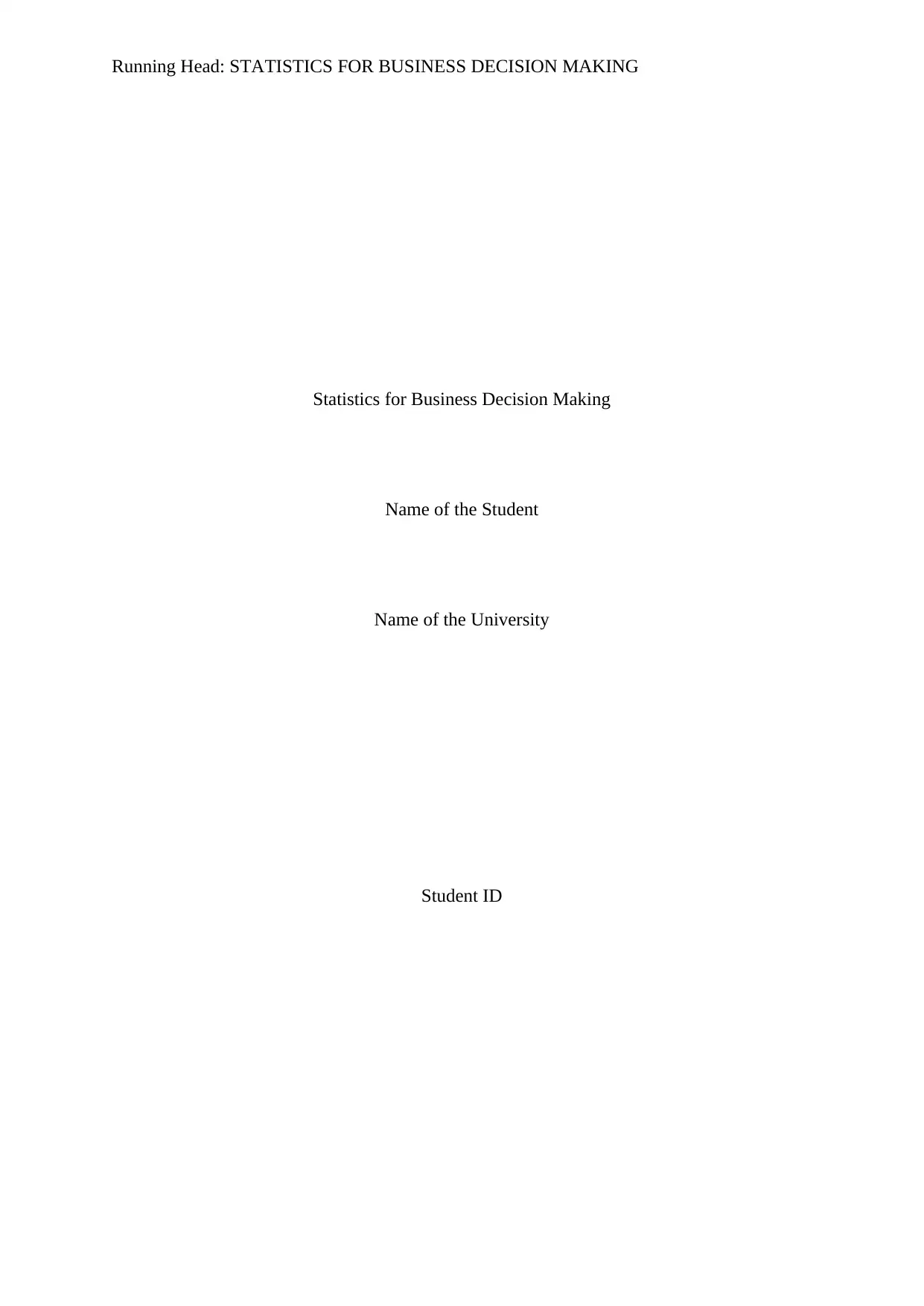
Running Head: STATISTICS FOR BUSINESS DECISION MAKING
Statistics for Business Decision Making
Name of the Student
Name of the University
Student ID
Statistics for Business Decision Making
Name of the Student
Name of the University
Student ID
Paraphrase This Document
Need a fresh take? Get an instant paraphrase of this document with our AI Paraphraser

1STATISTICS FOR BUSINESS DECISION MAKING
Table of Contents
Answer 1....................................................................................................................................2
Answer 2....................................................................................................................................3
Answer 3....................................................................................................................................3
Answer 4....................................................................................................................................4
Table of Contents
Answer 1....................................................................................................................................2
Answer 2....................................................................................................................................3
Answer 3....................................................................................................................................3
Answer 4....................................................................................................................................4
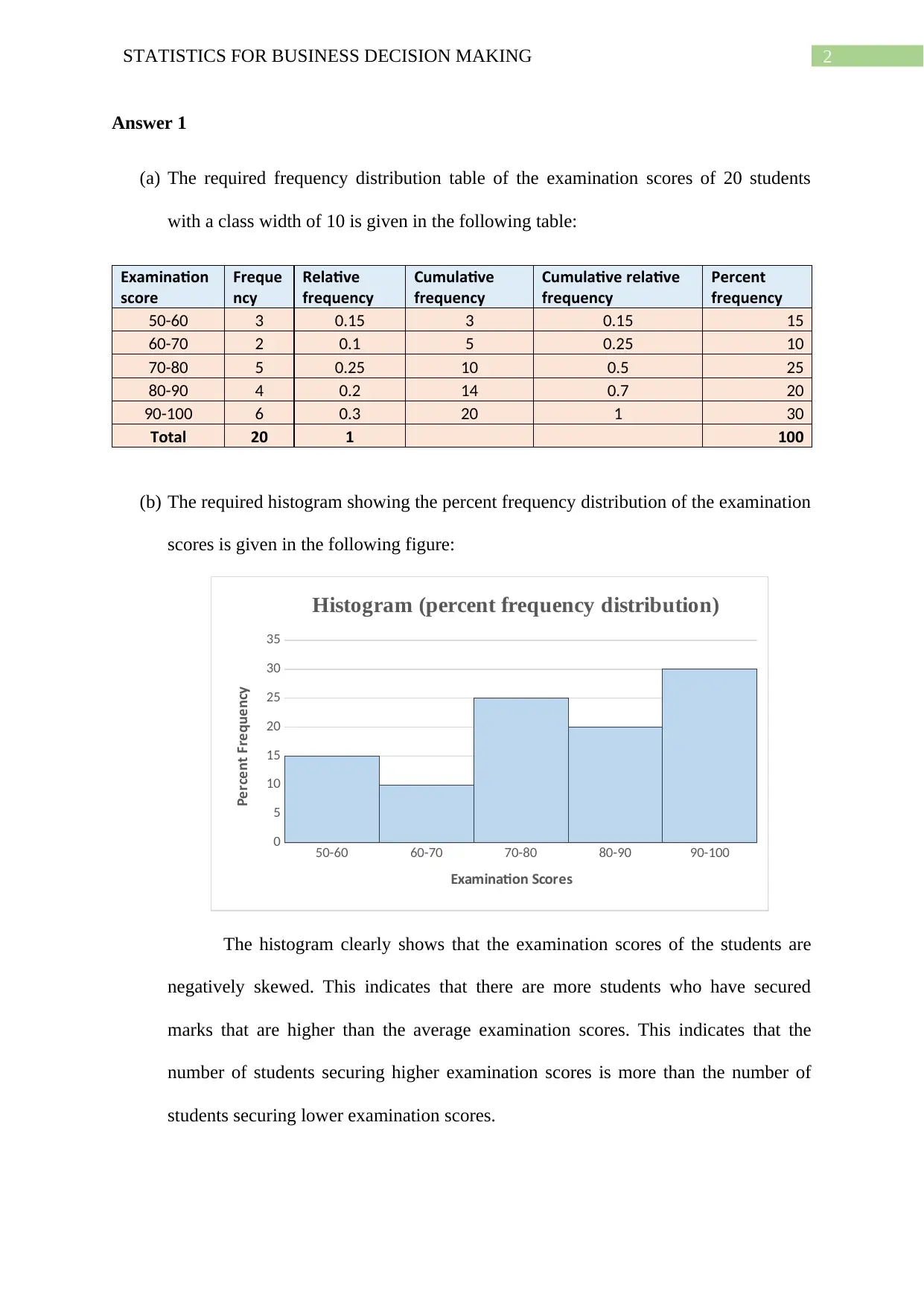
2STATISTICS FOR BUSINESS DECISION MAKING
Answer 1
(a) The required frequency distribution table of the examination scores of 20 students
with a class width of 10 is given in the following table:
Examination
score
Freque
ncy
Relative
frequency
Cumulative
frequency
Cumulative relative
frequency
Percent
frequency
50-60 3 0.15 3 0.15 15
60-70 2 0.1 5 0.25 10
70-80 5 0.25 10 0.5 25
80-90 4 0.2 14 0.7 20
90-100 6 0.3 20 1 30
Total 20 1 100
(b) The required histogram showing the percent frequency distribution of the examination
scores is given in the following figure:
50-60 60-70 70-80 80-90 90-100
0
5
10
15
20
25
30
35
Histogram (percent frequency distribution)
Examination Scores
Percent Frequency
The histogram clearly shows that the examination scores of the students are
negatively skewed. This indicates that there are more students who have secured
marks that are higher than the average examination scores. This indicates that the
number of students securing higher examination scores is more than the number of
students securing lower examination scores.
Answer 1
(a) The required frequency distribution table of the examination scores of 20 students
with a class width of 10 is given in the following table:
Examination
score
Freque
ncy
Relative
frequency
Cumulative
frequency
Cumulative relative
frequency
Percent
frequency
50-60 3 0.15 3 0.15 15
60-70 2 0.1 5 0.25 10
70-80 5 0.25 10 0.5 25
80-90 4 0.2 14 0.7 20
90-100 6 0.3 20 1 30
Total 20 1 100
(b) The required histogram showing the percent frequency distribution of the examination
scores is given in the following figure:
50-60 60-70 70-80 80-90 90-100
0
5
10
15
20
25
30
35
Histogram (percent frequency distribution)
Examination Scores
Percent Frequency
The histogram clearly shows that the examination scores of the students are
negatively skewed. This indicates that there are more students who have secured
marks that are higher than the average examination scores. This indicates that the
number of students securing higher examination scores is more than the number of
students securing lower examination scores.
⊘ This is a preview!⊘
Do you want full access?
Subscribe today to unlock all pages.

Trusted by 1+ million students worldwide
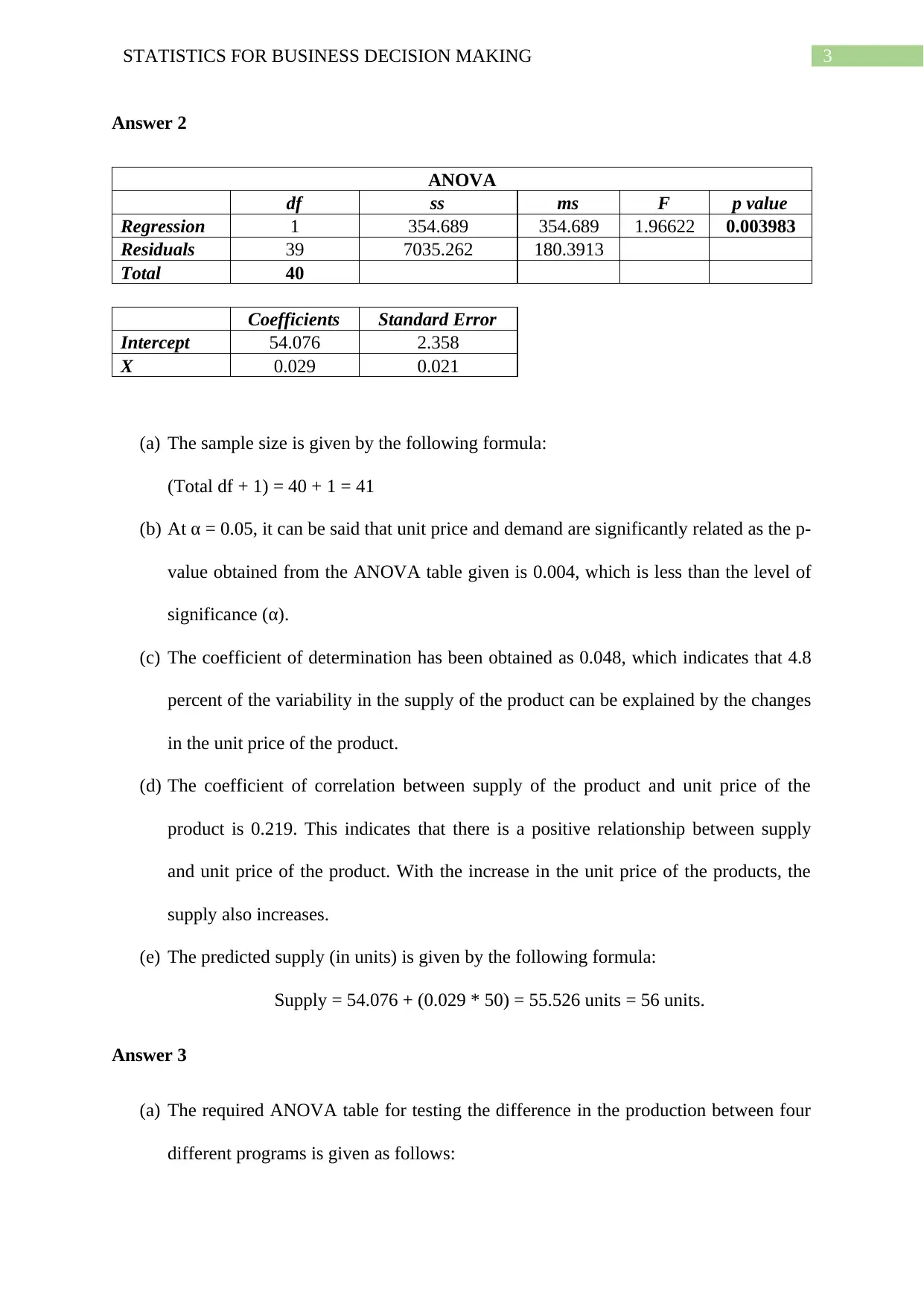
3STATISTICS FOR BUSINESS DECISION MAKING
Answer 2
ANOVA
df ss ms F p value
Regression 1 354.689 354.689 1.96622 0.003983
Residuals 39 7035.262 180.3913
Total 40
Coefficients Standard Error
Intercept 54.076 2.358
X 0.029 0.021
(a) The sample size is given by the following formula:
(Total df + 1) = 40 + 1 = 41
(b) At α = 0.05, it can be said that unit price and demand are significantly related as the p-
value obtained from the ANOVA table given is 0.004, which is less than the level of
significance (α).
(c) The coefficient of determination has been obtained as 0.048, which indicates that 4.8
percent of the variability in the supply of the product can be explained by the changes
in the unit price of the product.
(d) The coefficient of correlation between supply of the product and unit price of the
product is 0.219. This indicates that there is a positive relationship between supply
and unit price of the product. With the increase in the unit price of the products, the
supply also increases.
(e) The predicted supply (in units) is given by the following formula:
Supply = 54.076 + (0.029 * 50) = 55.526 units = 56 units.
Answer 3
(a) The required ANOVA table for testing the difference in the production between four
different programs is given as follows:
Answer 2
ANOVA
df ss ms F p value
Regression 1 354.689 354.689 1.96622 0.003983
Residuals 39 7035.262 180.3913
Total 40
Coefficients Standard Error
Intercept 54.076 2.358
X 0.029 0.021
(a) The sample size is given by the following formula:
(Total df + 1) = 40 + 1 = 41
(b) At α = 0.05, it can be said that unit price and demand are significantly related as the p-
value obtained from the ANOVA table given is 0.004, which is less than the level of
significance (α).
(c) The coefficient of determination has been obtained as 0.048, which indicates that 4.8
percent of the variability in the supply of the product can be explained by the changes
in the unit price of the product.
(d) The coefficient of correlation between supply of the product and unit price of the
product is 0.219. This indicates that there is a positive relationship between supply
and unit price of the product. With the increase in the unit price of the products, the
supply also increases.
(e) The predicted supply (in units) is given by the following formula:
Supply = 54.076 + (0.029 * 50) = 55.526 units = 56 units.
Answer 3
(a) The required ANOVA table for testing the difference in the production between four
different programs is given as follows:
Paraphrase This Document
Need a fresh take? Get an instant paraphrase of this document with our AI Paraphraser
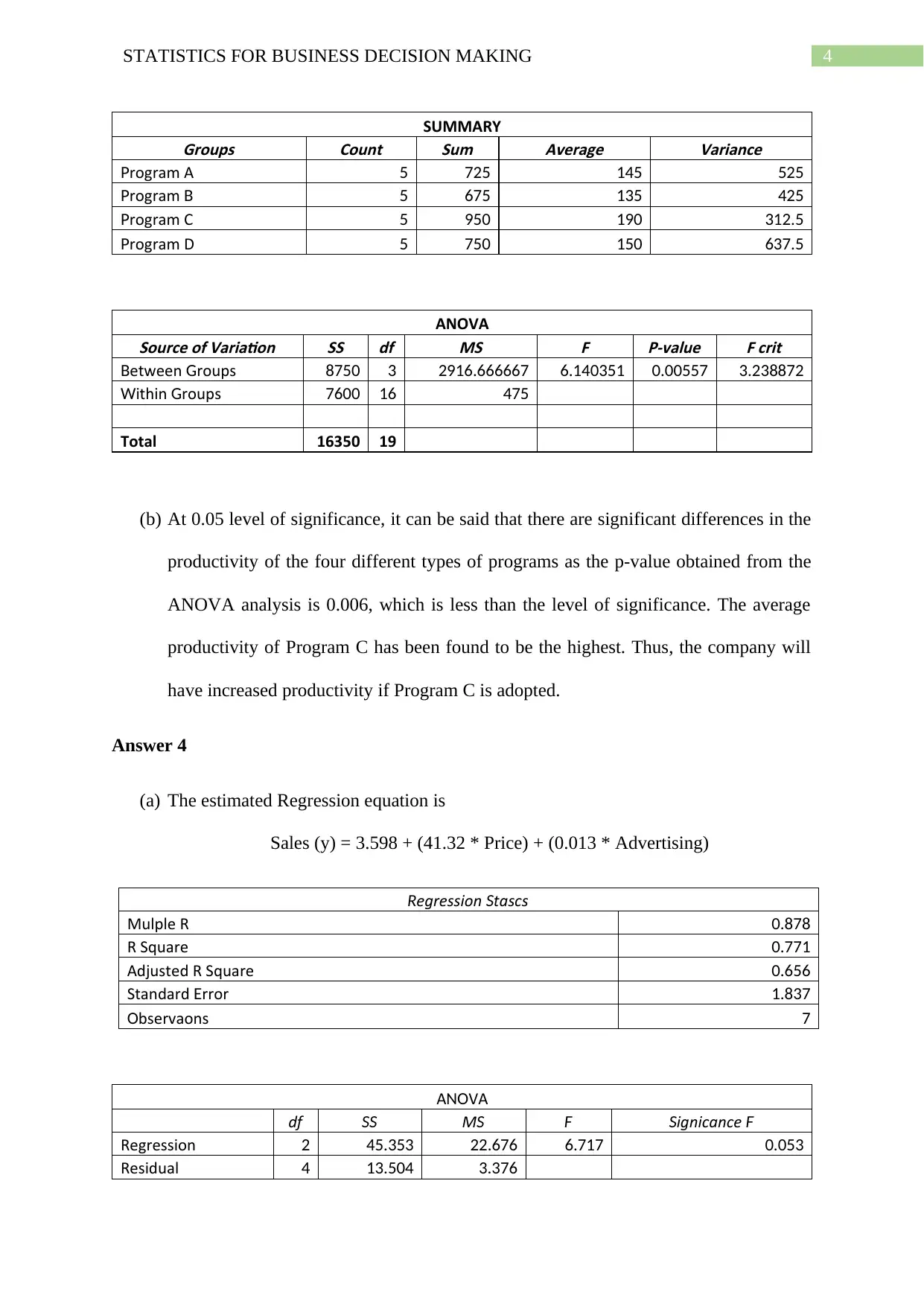
4STATISTICS FOR BUSINESS DECISION MAKING
SUMMARY
Groups
Count Sum
Average
Variance
rogram AP 5 725 145 525
rogramP B 5 675 135 425
rogram CP 5 950 190 312.5
rogram DP 5 750 150 637.5
ANOVA
Source of Variation SS df MS
F P-value F crit
etween roupsB G 8750 3 2916.666667 6.140351 0.00557 3.238872
ithin roupsW G 7600 16 475
Total 16350 19
(b) At 0.05 level of significance, it can be said that there are significant differences in the
productivity of the four different types of programs as the p-value obtained from the
ANOVA analysis is 0.006, which is less than the level of significance. The average
productivity of Program C has been found to be the highest. Thus, the company will
have increased productivity if Program C is adopted.
Answer 4
(a) The estimated Regression equation is
Sales (y) = 3.598 + (41.32 * Price) + (0.013 * Advertising)
egression tatisticsR S
Multiple R 0.878
R Square 0.771
Adjusted R Square 0.656
Standard rrorE 1.837
bservationsO 7
A VANO
df SS MS F ignificanceS F
Regression 2 45.353 22.676 6.717 0.053
Residual 4 13.504 3.376
SUMMARY
Groups
Count Sum
Average
Variance
rogram AP 5 725 145 525
rogramP B 5 675 135 425
rogram CP 5 950 190 312.5
rogram DP 5 750 150 637.5
ANOVA
Source of Variation SS df MS
F P-value F crit
etween roupsB G 8750 3 2916.666667 6.140351 0.00557 3.238872
ithin roupsW G 7600 16 475
Total 16350 19
(b) At 0.05 level of significance, it can be said that there are significant differences in the
productivity of the four different types of programs as the p-value obtained from the
ANOVA analysis is 0.006, which is less than the level of significance. The average
productivity of Program C has been found to be the highest. Thus, the company will
have increased productivity if Program C is adopted.
Answer 4
(a) The estimated Regression equation is
Sales (y) = 3.598 + (41.32 * Price) + (0.013 * Advertising)
egression tatisticsR S
Multiple R 0.878
R Square 0.771
Adjusted R Square 0.656
Standard rrorE 1.837
bservationsO 7
A VANO
df SS MS F ignificanceS F
Regression 2 45.353 22.676 6.717 0.053
Residual 4 13.504 3.376
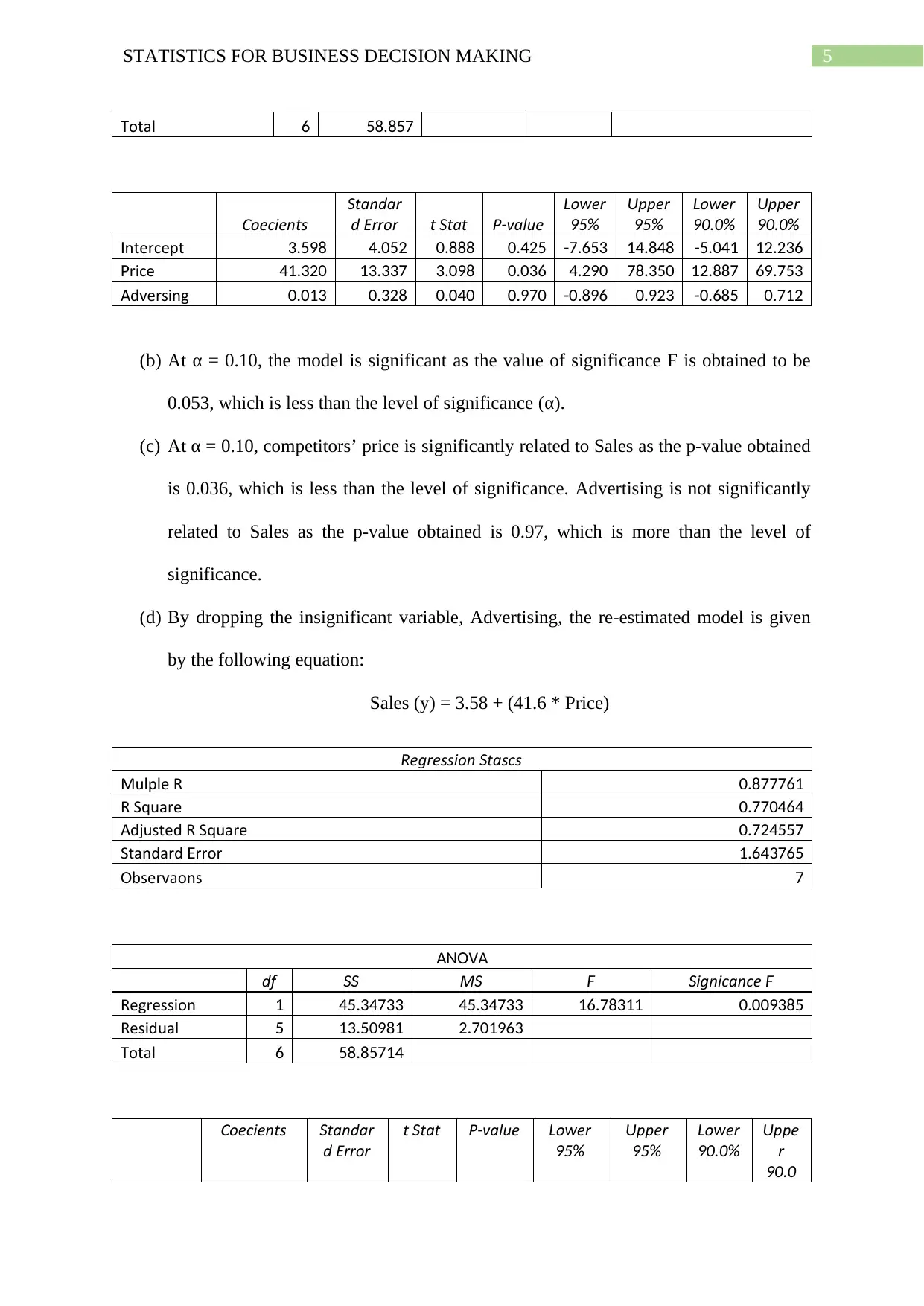
5STATISTICS FOR BUSINESS DECISION MAKING
otalT 6 58.857
Coefficients
tandarS
d Error t tatS P value-
o erL w
95%
pperU
95%
o erL w
90.0%
pperU
90.0%
nterceptI 3.598 4.052 0.888 0.425 -7.653 14.848 -5.041 12.236
riceP 41.320 13.337 3.098 0.036 4.290 78.350 12.887 69.753
Advertising 0.013 0.328 0.040 0.970 -0.896 0.923 -0.685 0.712
(b) At α = 0.10, the model is significant as the value of significance F is obtained to be
0.053, which is less than the level of significance (α).
(c) At α = 0.10, competitors’ price is significantly related to Sales as the p-value obtained
is 0.036, which is less than the level of significance. Advertising is not significantly
related to Sales as the p-value obtained is 0.97, which is more than the level of
significance.
(d) By dropping the insignificant variable, Advertising, the re-estimated model is given
by the following equation:
Sales (y) = 3.58 + (41.6 * Price)
egression tatisticsR S
Multiple R 0.877761
R Square 0.770464
Adjusted R Square 0.724557
Standard rrorE 1.643765
bservationsO 7
A VANO
df SS MS F ignificanceS F
Regression 1 45.34733 45.34733 16.78311 0.009385
Residual 5 13.50981 2.701963
otalT 6 58.85714
Coefficients tandarS
d Error
t tatS P value- o erL w
95%
pperU
95%
o erL w
90.0%
ppeU
r
90.0
otalT 6 58.857
Coefficients
tandarS
d Error t tatS P value-
o erL w
95%
pperU
95%
o erL w
90.0%
pperU
90.0%
nterceptI 3.598 4.052 0.888 0.425 -7.653 14.848 -5.041 12.236
riceP 41.320 13.337 3.098 0.036 4.290 78.350 12.887 69.753
Advertising 0.013 0.328 0.040 0.970 -0.896 0.923 -0.685 0.712
(b) At α = 0.10, the model is significant as the value of significance F is obtained to be
0.053, which is less than the level of significance (α).
(c) At α = 0.10, competitors’ price is significantly related to Sales as the p-value obtained
is 0.036, which is less than the level of significance. Advertising is not significantly
related to Sales as the p-value obtained is 0.97, which is more than the level of
significance.
(d) By dropping the insignificant variable, Advertising, the re-estimated model is given
by the following equation:
Sales (y) = 3.58 + (41.6 * Price)
egression tatisticsR S
Multiple R 0.877761
R Square 0.770464
Adjusted R Square 0.724557
Standard rrorE 1.643765
bservationsO 7
A VANO
df SS MS F ignificanceS F
Regression 1 45.34733 45.34733 16.78311 0.009385
Residual 5 13.50981 2.701963
otalT 6 58.85714
Coefficients tandarS
d Error
t tatS P value- o erL w
95%
pperU
95%
o erL w
90.0%
ppeU
r
90.0
⊘ This is a preview!⊘
Do you want full access?
Subscribe today to unlock all pages.

Trusted by 1+ million students worldwide
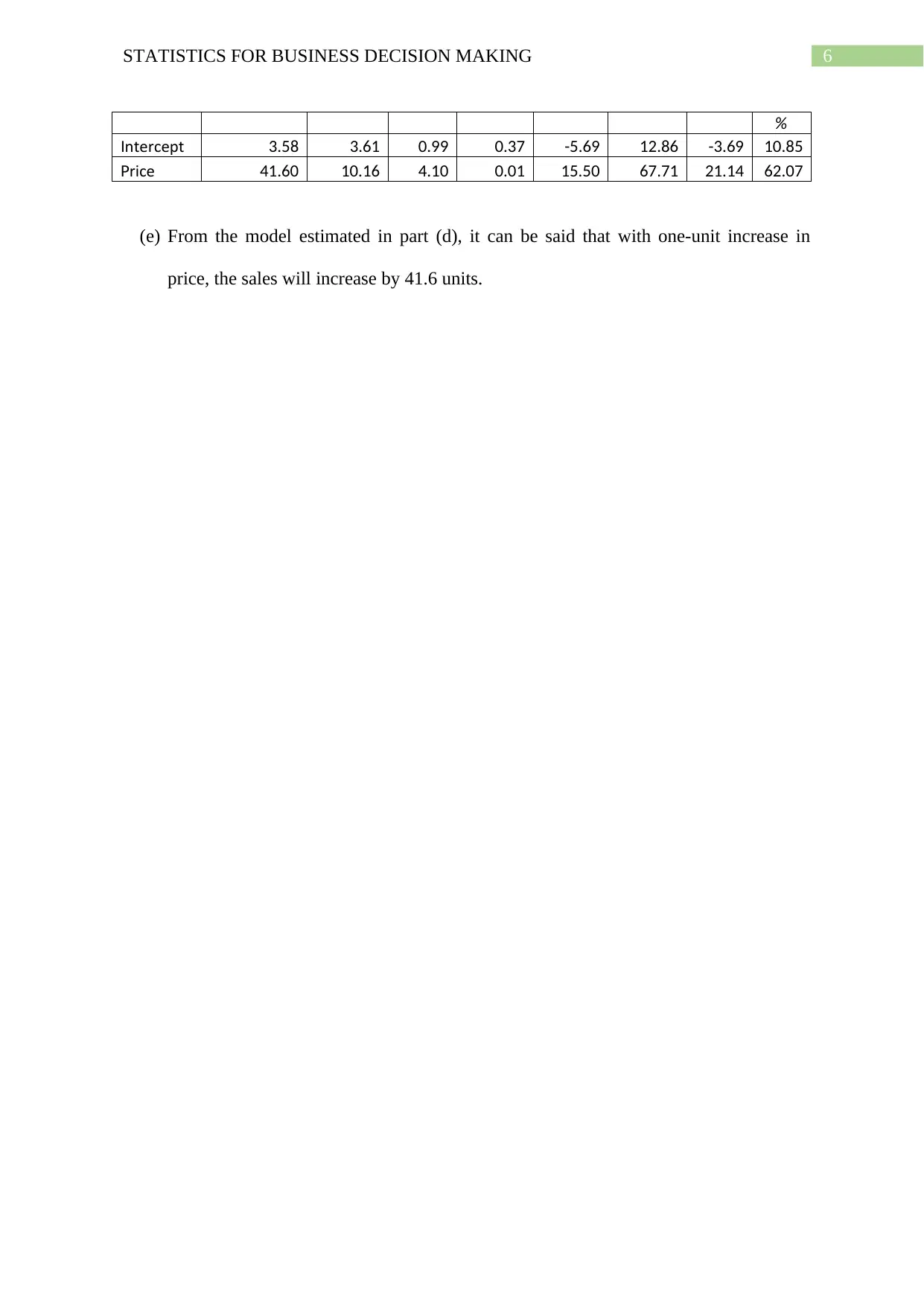
6STATISTICS FOR BUSINESS DECISION MAKING
%
nterceptI 3.58 3.61 0.99 0.37 -5.69 12.86 -3.69 10.85
riceP 41.60 10.16 4.10 0.01 15.50 67.71 21.14 62.07
(e) From the model estimated in part (d), it can be said that with one-unit increase in
price, the sales will increase by 41.6 units.
%
nterceptI 3.58 3.61 0.99 0.37 -5.69 12.86 -3.69 10.85
riceP 41.60 10.16 4.10 0.01 15.50 67.71 21.14 62.07
(e) From the model estimated in part (d), it can be said that with one-unit increase in
price, the sales will increase by 41.6 units.
1 out of 7
Related Documents
Your All-in-One AI-Powered Toolkit for Academic Success.
+13062052269
info@desklib.com
Available 24*7 on WhatsApp / Email
![[object Object]](/_next/static/media/star-bottom.7253800d.svg)
Unlock your academic potential
Copyright © 2020–2025 A2Z Services. All Rights Reserved. Developed and managed by ZUCOL.



